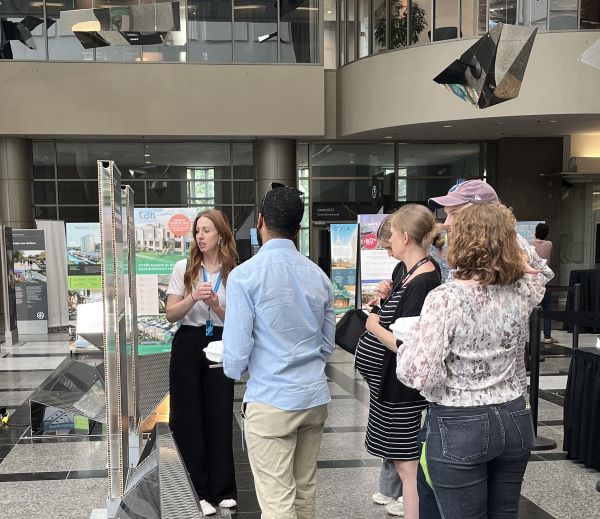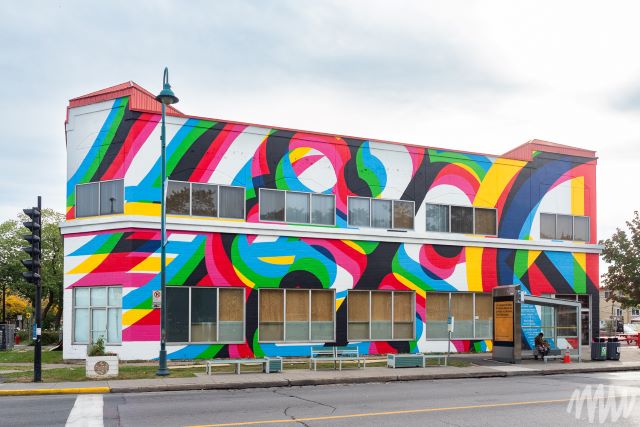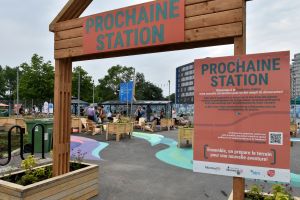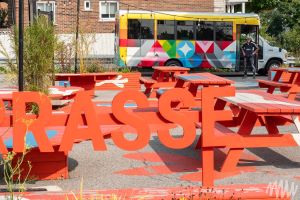Upcoming information sessions
Sessions will be held in the near future, depending on where the worksites are located. You can choose between virtual or in-person participation, and ask your questions in advance when you fill out the online registration form.
The sessions will be held in French, but you can ask your question in English.
Lacordaire and Anjou sectors : Upcoming sessions
Past sessions
An information session was held on October 10, 2024, to inform residents about the start of work to build the new métro station in the Langelier area and the resulting full closure of Jean-Talon Street.
Consult the presentation (French only)
An information session was held on September 18, 2024, to inform residents about the start of work to build the new métro station in the Viau area and the resulting full closure of Jean-Talon Street.
Consult the presentation (French only)
An information session was held on September 12, 2024, to inform residents about the start of work to build the new métro station in the Pie-IX area and the resulting full closure of Jean-Talon Street.
Consult the presentation (French only)
Following efforts to optimize the Blue line project, the locations of certain operational infrastructures in the Anjou area have changed.
The Anjou terminal station will have two entrance buildings to serve the areas west and east of Highway 25. After studying several scenarios with the project partners, we reviewed the locations of the infrastructures needed to operate the métro in Anjou and created a final plan.
On February 22, 2023, an information session was held with residents from the Anjou area to present new infrastructure locations.
Watch the recording of the information session (in French only)
Answers to questions asked by residents during the information session:
For now, the STM’s mandate is to build the station. Discussions are underway with the City, Ivanhoé Cambridge and the project partners regarding development of the area. But nothing is planned for the moment.
Yes, the station will be designed to be integrated with the surrounding bike network. Customers will be able to go from one entrance building to the other with a bicycle based on the STM’s policy.
Planning access to the new station for all users in the area is the responsibility of the project partners. They are currently discussing access to the new station. That being said, at this stage, any plan to build such an access is still unknown.
In addition, with the arrival of the new stations, the bus network will be redesigned to optimize travel for users in and around the area and promote intermodality.
Traditional excavation methods will be used east of Highway 25. Excavation will be mostly mechanical, but blasting will be required in certain areas. The STM aims to minimize the impact of the Blue line extension on resident’s daily lives and will deploy several mitigation measures, such as monitoring sound and vibration levels.
Blasting will be necessary in certain areas where open-pit excavation will take place. The STM works with highly qualified blasting experts and is experienced in doing these kinds of operations in dense urban areas. Rest assured that the STM will implement all necessary measures to ensure resident safety, preserve building integrity and protect the environment.
It is very unlikely that neighbouring buildings will be damaged during the work. An independent consulting firm will be hired to survey (photograph) the buildings around the worksite. These inspections will document the condition of the buildings before and after the work. Property owners affected by this measure will be notified accordingly.
The Blue line project will take place in a dense urban environment where many types of activities are happening. Infrastructure locations are chosen based on operational criteria and needs.
As we usually do, we will carry out the work safely and in compliance with requirements. The implementation strategies will be presented during the next information session before the work beings.
As principal contractor and project manager, the STM is mandated to carry out the Blue line project according to the final scope approved by the government last March. A tunnel between the future Anjou station and Honoré-Beaugrand station is not part of the scope of this project.
The noise made by equipment inside auxiliary structures is compliant with the City of Montréal noise by-laws. Huge noise suppressors mitigate the noise from the fans, installed below ground level, to ensure quiet for residents living nearby. The noise coming from auxiliary structures can be compared roughly to the noise from a domestic dishwasher.
Azur trains will run on the entire Blue line as soon as the five new stations are commissioned. We must replace the train control system on the current Blue line to ensure that it matches the new technology that will be used on the extension. This is because MR-73 trains are not compatible with the new equipment.
Additionally, since Azur trains must have nine cars, we will redesign the platforms at Saint-Michel station to ensure that they are long enough to accommodate these trains.
Join your local good neighbour committee!
Over the next few months, we’ll be setting up good neighbour committees as a space for local residents to represent their community to the Blue line project office. Three committees will start meeting this fall:
Pie-IX and Provencher area
Future Pie-IX station* and Provencher auxiliary building
Viau and De Lisieux area
Future Viau station* and De Lisieux auxiliary building
Langelier area
Future Langelier station*
*Working names.
The committee’s purpose is to:
- Provide information and outline the different phases of the project.
- Start a dialogue between residents and project representatives that will continue throughout the work.
- Discuss how the impact of the work will be managed so that resident members can share this information with their local community.
- Understand the concerns residents have about the work and find solutions together.
- Allow local residents to make suggestions on specific topics chosen by the project office.
Click here to find out more about the committees, including how often they’ll meet, who can join, and how to apply.
Throughout the project, more committees will be created to foster dialogue with the community. Committee members are recruited at strategic intervals, a few months before the work begins in a given area. Interested residents can apply via our electronic newsletters or the dedicated web page for each worksite.
2020 Public consultation
Publication of the Commission’s report and the STM’s action plan
In February and March 2020, a public consultation process took place in the form of several information evenings and input sessions. The goal of this community dialogue was to design a project that would integrate seamlessly into the lives of Montrealers.
The Commission leading this process has submitted its report and issued 43 recommendations that will allow us to enrich the project and produce infrastructure that meets the expectations of our customers and citizens. Read the Commission's report and the STM's action plan.
Key facts:
- 9 information evenings and input sessions
- 631 attendees
- 80 people took the floor to ask questions
- 85 inputs submitted to the Commission
- 50 participations in the guided online survey
Opportunities for community members to learn more about the different major steps structuring the STM’s approach to the project.
Presentation - Information evening
Answers to questions left unanswered during information sessions
- Saint-Michel area
Tuesday, February 11, 2020
Transcript
- Saint-Léonard area
Thursday, February 13, 2020
Transcript
- Anjou area
Tuesday, February 18, 2020
Transcript
- STM head office
Wednesday, February 19, 2020
Transcript
Opportunities for community members to share expectations or comments related to the Blue line project.
- Saint-Michel area
Wednesday, February 26, 2020
Transcript
Input presented to the Commission - Saint-Léonard area
Monday, March 2, 2020
Transcript
Input presented to the Commission - STM head office
Tuesday, March 3, 2020
Transcript
Input presented to the Commission - Anjou area
Wednesday, March 4, 2020
Transcript
Input presented to the Commission - STM head office
Thursday, March 5, 2020
Transcript
Input presented to the Commission
Politique corporative - French only
Commission's questions adressed to the STM - French only
STM's responses to Commission's questions - French only
Summary of decision-making process for the final route and infrastructure locations - French only
La famille signalétique guide - French only
Find out more
Read the preliminary vision for the development of the territory prepared by the City of Montréal (in french only).
To carry out the Blue line project, and especially to construct its new buildings (stations and auxiliary structures), the STM must obtain a by-law from the City of Montréal’s Agglomeration Council. This by-law enacts the urban planning rules that the STM must follow when performing the work for the project.
To obtain the by-law, the STM must first hold a public consultation in accordance with its corporate policy entitled Politique de consultation publique – réseau du métro (PC 1.14).
- Our board of Directors is initiating the consultation process by creating a Commission.
- The commission is made up of a chairperson and two commissioners from outside the STM who are mandated by the Board.
- Citizens are informed through various communication channels, such as the STM’s website, newspapers, signage at worksites and invitations delivered to residents’ mailboxes.
- The commission involves:
- An information session where the project is presented, followed by a question period
- An input session
- After the consultation, the commissioners submit their report to the STM along with their recommendations. The commission’s work is complete once the report is submitted.
Marguerite Bourgeois, Commission Chair
Marguerite Bourgeois graduated from McGill University in science and law and has worked in the industrial, services and manufacturing sectors for private and public companies including Alcan, Loto-Québec, Fonorola and IPEX. She has a strong background in legal and corporate affairs leadership, strategic planning, project management and start-ups on both a national and international scale. She has put this diverse professional background to use as ad hoc commissioner of the Office de consultation publique de Montréal and at the STM.
Ms. Bourgeois has always paired her professional activity with social engagement, whether as a Centraide committee member, as president of the Duke of Edinburgh’s Award, Quebec Division, as a member of the Association of Volunteer Guides at the Montreal Museum of Fine Arts, or as part of other paraprofessional and community groups.
Ms. Bourgeois successfully completes her mandates with the help of her people- and results-oriented approach, organization, and negotiation skills.
Joshua Wolfe, Commissioner
Joshua Wolfe has a master’s in urban planning from Université de Montréal and a bachelor’s in science and human affairs from Concordia University. He works as a sustainable development advisor for municipalities and NGOs. In 1990, he was accepted as a member of the American Institute of Certified Planners. He has taught city sustainable development and public participation at Concordia University, at UCLA Extension in the Public Policy Program, at McGill University, at the Institut international de gestion des grandes métropoles and the International Association for Public Participation (IAP2). A Montréal native, Mr. Wolfe has also lived in California, where he carried out environmental impact studies and prepared urban plans for various municipalities and other public organizations in the San Francisco and San Diego areas. He was ad hoc commissioner of the Office de consultation publique de Montréal from 2002 to 2008 and from 2011 to 2019.
Radouan Torkmani, Commissioner
Radouan Torkmani has an education in both engineering and architecture and currently works on developing, planning and coordinating projects to construct new schools. In addition, he has a keen interest in issues related to urban mobility and utilizes dialogue with users in his architectural research to conceive and determine best ways forward. A specialist in active, consensus-based research, Mr. Torkmani has displayed exemplary social engagement as well as great vision and leadership abilities. He is vice president of the Ordre des Ingénieurs du Québec Foundation and a member of the Groupe des 30, an initiative that brings together 30 ambassadors with board of directors experience to encourage other talented individuals to follow in their footsteps.
Events
Block parties
Summertime is when the Blue line project team hits the streets to meet the project’s future neighbours.
Come meet us at three events this summer:
Saturday, June 5, 2024: St-Léonard Fête des voisins on Jean-Talon Street East
Saturday, September 7, 2024: Anjou open house day
Sunday, September 8, 2024: St-Léonard Fête du citoyen

After attending these events, the Blue line project team confirmed residents’ enthusiasm for the long-awaited project.
In 2023, the team attended three special events to speak with local residents, answer their questions and hear their concerns.
- The Jean-Talon Street East Fête des voisins of Saint-Léonard (June 3, 2023)
- The Anjou borough open house day (September 9, 2023)
- The Saint-Léonard borough Fête du citoyen (September 10, 2023)
Block parties are a great opportunity to meet Montrealers living along the planned route of the extension.
On September 11, 2022, the Blue line project team attended the Saint-Léonard borough’s Fête du citoyen.
Exhibition
Montréal du future, lobby of 1000 De La Gauchetière (June 14 to 20, 2023)

The exhibition showcased a variety of projects that will change the face of Greater Montréal in the coming years. The Blue line project team was on hand to discuss the location of future métro stations and answer questions from the public.
Targeted information sessions
Le 22 residence (November 2, 2023)
Located near Le Boulevard shopping centre (CAB) and the future Pie-IX station, these residences have witnessed the transformations underway at the CAB. Our team gave a presentation on the Blue line project as a whole, the redevelopment of the CAB and our plans for infrastructure and operations in the Pie-IX area.

Other initiatives
The Blue line project team is eager to support initiatives aimed at enhancing the neighbourhoods where its stations will be built.
Mural at the corner of Jean-Talon and Lacordaire
If you’ve been at the corner of Jean-Talon and Lacordaire lately, you probably noticed the bright colours now decorating the street .

Photo: Olivier Bousquet
With the help of municipal funding, the Société de développement commercial de la rue Jean-Talon Est (SDC) teamed up with local arts organization MU to create a new piece of public art on an STM-owned building on Jean-Talon, breathing new life into the street.
Temporary public spaces in the Lacordaire area
Prochaine station square and Terrasse de Léon
Two STM-owned sites at the corner of Lacordaire and Jean-Talon were loaned to the SDC and the borough and transformed into fun community spaces for local residents to enjoy.


The Blue line project follows in the wake of the Déclaration du gouvernement du Québec et de la Ville de Montréal to revitalize Montréal East. Many projects are underway to give a new impetus to this sector. Increased mobility, economic development, and improved living environments are at the heart of this ambitious project. For more information, see Québec.ca/RevitalisationEstMontreal (in French only).
